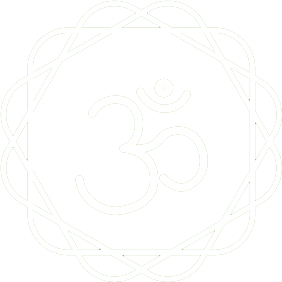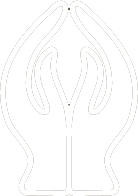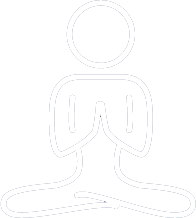The Yoga postures or the asanas are to be held and are to be performed slowly and meditatively. The word itself "asana" means stable position. While performing Yoga postures one should carefully understand and respect the following three stages:
- Coming into the pose.
- Holding it.
- Coming out of it.
The real work of an asana is done while we hold the position. Once we are able to relax in a pose, we can adjust the position to achieve a greater stretch. In the performance of the asanas one should always respect the limits of own body.
Specific indications are given in regards to the way one should breathe and concentrate the mind while in an asana. Performing body postures without the appropriate mind setting, breathing techniques and awareness is just doing physical exercise.
Their benefits come from a correct execution, but also from awareness and a conscious breathing process that opens the gates owards higher levels of consciousness.
Asanas are keeping the body in a state of health restoring the inner balance. These gentile movements not only work on all the various systems of the body (creating suppleness in the spine and joints, and toning the muscles, glands and internal organs) but also have profound effects spiritually, freeing us from fears and helping us to instill confidence and serenity. At the end of a yoga session, one will feel relaxed and full of energy - quite unlike after other forms of physical exercises.
Although extremely important on the path towards Yoga, through their more subtle effects on the prana, the senses and the mind, asanas should not be equaled to Yoga; they are in fact only a fraction, or a limb of the Great Yoga system.
Adhomukha Shvanasana
(The dog facing down)
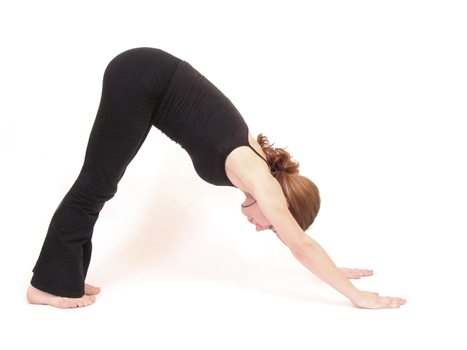
Benefits
- Tones the legs, the ankles, tbrhe shoulders, the abdominal muscles.
- Eliminates fatigue if you can maintain it for a longer time.
- Tones the muscles of the back and helps the spine keep straight and healthy.
- Stimulates the activity of the internal organs especially the kidneys, the liver and the genital organs.
Contraindications
- During pregnancy and during periods; In case of chronic eye problems.
Advasana
(Reversed corpse pose)

Benefits
- Recommended for those with slipped disc and stiff neck and all other spine related problems.
Contraindications
- No counter indications.
Ardha Chakrasana
(The half wheel pose)
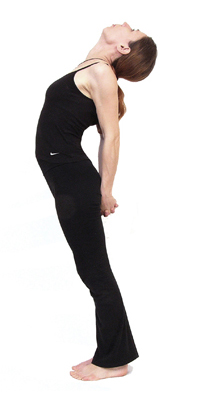
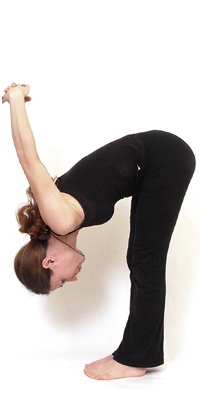
Benefits
- Corrects the position of the back.
- It stimulates the blood circulation and the activityof the heart.
- It increases the breathing capacity of the lungs.
- Give self-confidence and eliminates the fear and the anxiety.
Contraindications
- No counter indications.
Ardha Setu Bandasana
(The bridge)
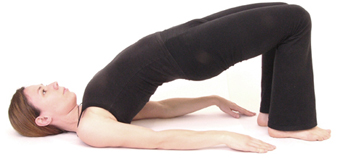
Benefits
- Gives more flexibility to the lumbar vertebra.
- Strengthens the abdominal muscles and thighs.
- Regulates the activity of the thyroid.
- Improves blood circulation and the activity of the heart.
- Fights different contractions and tensions in the neck area.
- An excellent practice for those with slipped disc, sciatica or lower back pain.
- Stretches the abdomen and tones the pelvic organs and kidneys.
Contraindications
- In case of different forms of sciatica, hernia and during pregnancy.
Ardha Matsyendrasana
(The pose of great yogi Matsyendra)
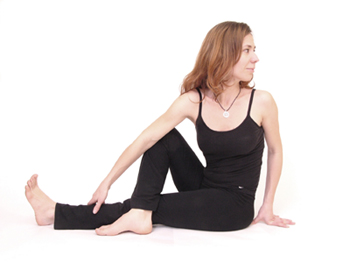
Benefits
- This pose stretches all the muscles and ligaments of the spineand it prevents pain in the back.
- It prevents the abnormal curves of the spine, and in case they already exist, they will be cured through perseverant practice.
- Its influence on the suprarenal glands and on the thyroid is beneficial. The compression of the abdomen tones the inner organs, stimulates them and increases the digestive fire. The constipation is eliminated.
- This pose tones the sympathetic nervous system and refreshes the organism. Favorable for the liver. Recommended in case of hollow back and excessive weight (obesity).
- In Yoga therapy is used for the management of bronchitis, constipation, colitis, menstrual disorders, urinary tract disorders as long as it can be performed without discomfort.
- It builds self-confidence and fights against the shyness. Recommended against the depressive states and the states of hyper nervousness.
Contraindications
- Women that are 2-3 months pregnant should avoid this practice.
- People suffering from ulcer, hernia or hyperthyroidism should avoid this practice.
- It is benefic in case of sciatica or slipped disc, but it should be performed with great care.
Balasana
(The childs pose)
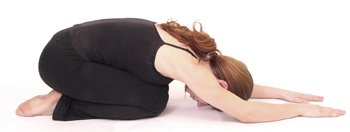
Benefits
- Eliminates the back pain; it relaxes the back by reducing the pressure between the vertebras.
- Against the deformations of the spinal column.
- It increases the resistance to stress and has a calming effect.
- Stimulates the blood circulation and favors the elimination of toxins.
Contraindications
- If fragile knees and if meniscus problems.
- Should be moderately practiced by people suffering of advanced arthritis or obesity.
Banarasana
(The monkey pose)
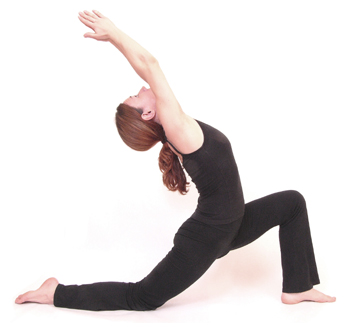
Benefits
- Gives more flexibility to the spine.
- Improves the breathing, giving more breathing capacity to the lungs.
- Improves the blood circulation; It is beneficial for female disorders related to the ovaries, uterus and the urinary tract.
- It gives a good stretch to the chest and neck relieving sore throat, cough and cold.
Contraindications
- In case of fragile knees.
- In case of specific spine problems such as: sciatica, painful degenerative osteoarthritis, and arthritis.
Bhujangasana
(The cobra)
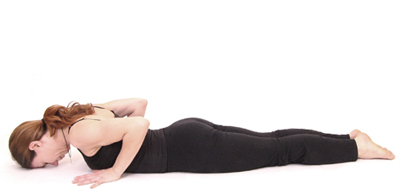
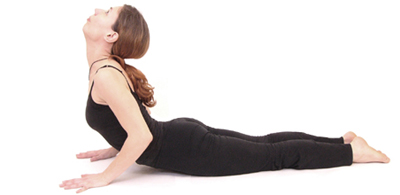
Benefits
- This asana keeps the spine flexible and young. It rapidly eliminates hunchback, pains in the back, lumbago crisis.
- It eliminates constipation, relieves indigestion and intestinal gas.
- Liver, bile, pancreas, spleen, kidneys are favored by this posture. Acts favorably on the nervous system, improving concentration.
- Benefic in the following situations: asthma, cellulite, depression, insomnia, lombarthose, hollow-back and obesity.
- This asana tones the ovaries and uterus and help alleviate menstrual and gynaecological disorders.
- Eliminates the feelings of uncertainty and inferiority, generates a tonic, spiritual, confident, loving attitude.
Contraindications
- When high blood pressure. Eye disorders, during menstruation and during pregnancy.
- If asthma, during the crisis if difficulties breathing. People suffering of peptic ulcer, hernia and hyperthyroidism should perform this asana carefully and only under supervision.
Dhanurasana
(The bow pose)
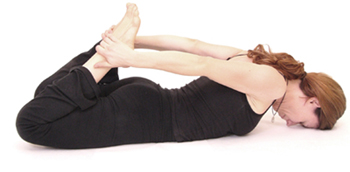
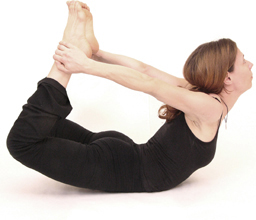
Benefits
- This asana prevents the premature calcification of the vertebral joints and it acts on the ligaments, muscles, and nervous centers placed along the spine.
- The acceleration of the breath, the decongestion of the solar plexus, the activation of the digestive system, the improvement of the blood flow in the cellulite or fat tissues, through a profound massage - all these arefactors which make this asana a valuable help in the fight against cellulite.
- This asana has a therapeutic effect on the thyroid.
- It acts efficiently on the digestive system, as well as on the annex glands.
- It eliminates constipation, the kidneys benefit of an increased quantity of blood, which has as immediate effect a more efficient elimination of toxins.
- The massage of the solar plexus reduces the anxiety.
- The stimulation of the nervous centers of the spine induces a state of euphoria in the practitioner.
Contraindications
- Avoid practicing this asana during menstruation and during pregnancy; In case of high blood pressure, week heart and in case of fragile shoulder or wrist.
- In case of spine problems, hernia, colitis, peptic or duodenal ulcer and during asthma crisis.
- It should not be performed at night before sleep as it stimulates the adrenal glands and the sympathetic nervous system.
Garudasana
(The eagle)
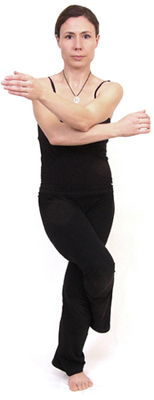

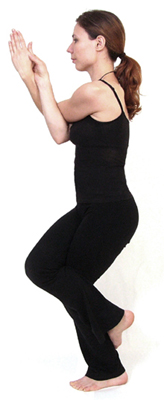
Benefits
- The nerves and the bones of the legs and arms are sternghtened. The nerves of the kidneys are also strengthened.
- Sciatica, rheumatism of the legs and hands are cured. The bines if the vertebral column get developed and strengthened.
- The muscles of the calves get developped and the nerves of the legs and hands are strengthened.
- It cures pain and arthritis of the joints. The muscles of the ankles, shanks, knees and thighs are strengthened.
- The sensations of rigidity of the shoulders are rapidly eliminated. Eliminates any feelings of tiredness.
- It gives a better concentration and mental stability.
Contraindications
- No counter indications.
Janushirshasana
(Head to knee pose)
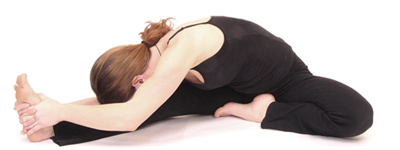
Benefits
- This posture is indicated to persons who have a rigid body.
- It strengthens the legs and it improves the blood circulation and it eliminates the unpleasant odors of the bodily secretions.
- It fortifies the liver, the spleen and the kidneys.
- It amplifies the digestive fire, improving the digestion.
- It is an energizing posture; it eliminates the state of laziness and inertia.
Contraindications
- No counter indications.
Katikasana
(The front stretching)
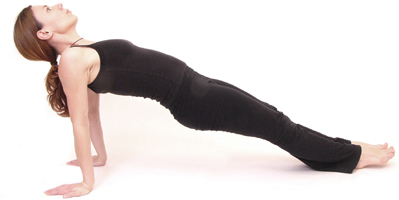
Benefits
- It strengthens the muscles of the arms and the back, the shoulders, the neck and the hips.
- It fortifies the thighs and the abdomen.
- Calming effect of the nervous system. Beneficial in case of hyper nervousness.
Contraindications
- In case of stiff neck, fragility or painful shoulders, hands, wrists and elbows.
Matsyasana
(The fish)
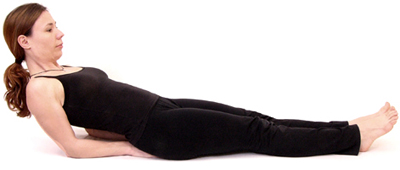
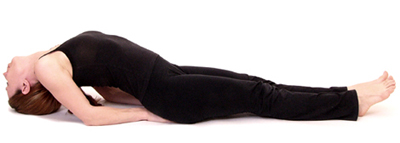
Benefits
- Tones the nerves of the neck and back.
- It expands the ribcage fully therefore it increases the lung capacity. It is recommended for asthma and bronchitis.
- Alleviates backache and cervical spondylitis.
- It regulates the function of the thyroid and the thymus gland, boosting the immune system.
- It improves the blood circulation and regulates the menstrual cycle.
- It tones the intestines and all internal organs.
Contraindications
- In case of stiff neck, fragile neck, heart disease, peptic ulcers, hernia.
- Pregnant women should not attempt to practice this asana.
Pashchimottanasana
(The forward bending)
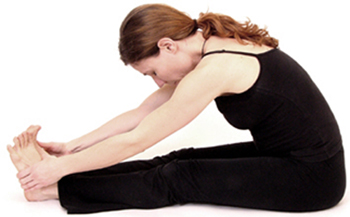
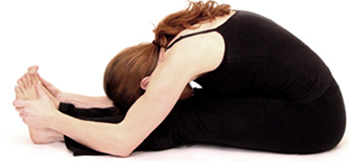
Benefits
- Tones and stimulates the internal organs.
- Brings a progressive flexibility of the spine.
- Favorable in case of asthma and other respiratory problems.
- This asana favors a better blood circulation in the entire body and especially in the pelvic area.
- It strengthens the thighs and tendons. Eliminates the unaesthetic deposits of fat from the abdomen and hips.
- Helps in the diffusion of anxious states. The mind becomes stable and calm, the breath calms down.
- It is used in Yoga therapy for the management of menstrual disorders, diabetes, colitis, kidney complaints.
Contraindications
- In all cases of slipped disc and sciatica.
Sarvangasana
(The shoulder stand)
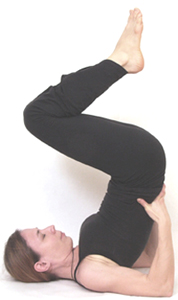
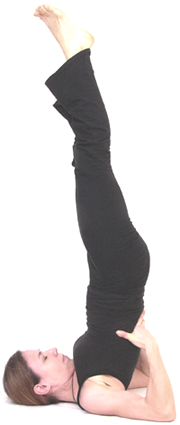
Benefits
- Abnormal physiologic curves of the spine are gradually eliminated.
- This asana keeps the thyroid in perfect health and a healthy thyroid means healthy functioning of all organs. The activity of the heart is stimulated.
- TIt supplies a large quantity of blood to the spinal roots of nerves and it keeps the spine quite elastic.
- It tones the legs, abdomen and reproductive organs draining stagnant blood and fluid and increasing circulation in those areas.
- Eliminates the throat infections and its regular practice help to prevent cold and flu.
- It strengthens the lower back muscles while it renders the spine more flexible.
- It stimulates the well functioning of the ovaries and it is very useful in gonorrhea and other diseases of bladder and ovaries. It removes sterility and diseases of womb.
- It is sedative of the nervous system and prepares for the sleep.
- It tranquillizes the mind, relieves mental and emotional stress, fear and headaches and helps clear psychological disturbances.
- Eliminates the states of irritation and insomnia.
- Suggested to fight against the irascible states and depression. In the same time it energizes, invigorates and vivifies.
- It is used in yoga therapy for the treatment of asthma, diabetes, colitis, thyroid disorders, impotence, menopause, menstrual disorders and leucorrhoea.
Contraindications
- In case of problems with the cervical area, in cases of cervical degenerative osteoarthritis.
- In case of heart problems and high blood pressure. Tendency to the nosebleeds. It should not be practiced by people suffering from enlarged thyroid, liver or spleen, cervical spondylitis, slipped disc.
- It should be avoided during menstruation and advanced stages of pregnancy.
Shalabasana
(The locust pose)
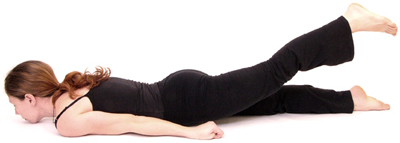
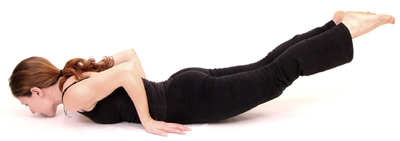
Benefits
- It strengthens the heart and it enhances the lumbar muscles. It prevents or heals certain stomach and intestine diseases. It relieves constipation and tones the abdominal viscera.
- It eliminates liver tiredness, dyspepsia. It strengthens the reproductive system and the lower back. nsures a better circulation in the legs.
- It keeps the spine elastic and gives a good massage to the abdominal organs. Lumbago is cured. The spinal nerve roots and sympathetic system are toned.
- It fights the cellulite. Favorable in the cases of insomnias and in the cases of menstrual problems.
- It tones the sciatic nerves, providing relief for those with conditions such as backache, mild sciatica and slipped disc as long as the condition is not serious.
- It should be practiced in case of depression it develops concentration.
Contraindications
- In case of advanced forms of vertebral rheumatism: arthritis, degenerative osteoarthritis.
- In case of slipped disc.
- In case of hollow-back, at the woman during the pregnancy.
- Not recommended for those who suffer of asthma.
- The pose requires a great deal of physical effort therefore it should not be practiced by people with weak heart or high blood pressure.
Sukasana
(The easy pose)
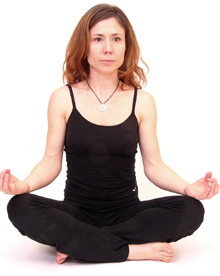
Benefits
- It calms down the mind.
- Amplifies the state of serenity, tranquility, eliminates the anxiety.
- It eliminates exhaustion and tiredness after a physically exhausting activity or after a monotonous mental activity.
- Helps us relaxing the muscles.
Contraindications
- No counter indications.
Trikonasana
(The triangle pose)
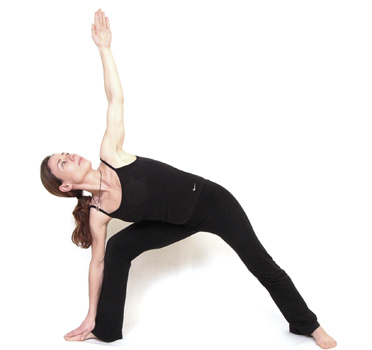
Benefits
- It stretches and develops the muscles of the spine.
- It reestablishes the breathing balance and ventilates the two lungs.
- The lateral movements of the trunk stretch and fortify the abdominal muscles as well as the muscles of the hips. The abdominal muscles are fortified and strengthened.
- This pose tones the muscles of the feet and the ankles, and it makes the hips and thighs more elastic.
- It eases the pain in the back and neck.
- It tones and stimulates the nerves situated in the lumbar area of the spine. This fact influences positively and directly all abdominal organs and especially the genital-uterine system.
Contraindications
- There are no contraindications with the condition that we execute it with care, without forcing.
- The pregnant women should not practice this asana after the 4th month of pregnancy.
Utthanasana
(The squatting pose)
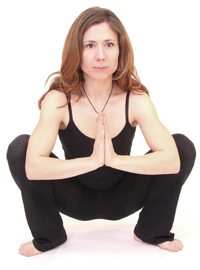
Benefits
- It tones the thighs, the ankles and the knees.
- Stimulates the blood circulation and the activity of the heart and nervous system.
- Stimulates the brain through a better blood circulation and leads to a better concentration.
Contraindications
- In case of fragility of knees and menisci.
Uttytha Dhanurasana
(The rising arch)
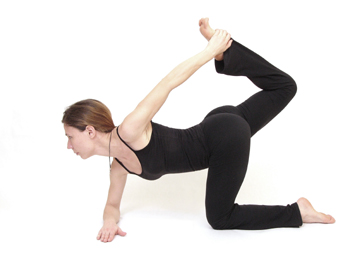
Benefits
- It prevents premature ossification of the spine and confers a correct static to it.
- It stimulates the nervous centers placed along the spine. It corrects the breath and activates the digestive system.
- It stimulates the endocrine gland. Eliminates constipation; the kidneys eliminate the toxins to a higher degree.
- It fights cellulite and helps reduce weight; it can be practiced all the time, even during menstrual period by women.
- It stimulates the sympathetic nervous system whose ganglions are situated along the spine, from where the euphoric state of mind generated by the pose.
- An increased secretion of adrenaline will energize the persons who are either depressed or under a negative state of mind.
- The cortisone secretion is also improved therefore the position corrects certain forms of rheumatism.
- Recommended in the Yoga therapy for cases of anxiety and fears.
Contraindications
- Pregnant women should practice it only up the 4th month.
Vajrasana
(The diamond pose)
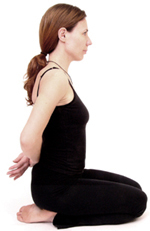
Benefits
- Spirit in your heart and heart in your spirit; Ideal Position for the consideration or the exercises of pranayama (breathing), Dharana (concentration) and Dhyana (meditation).
- Eliminates the rheumatic disorders. It regenerates and relaxes the lumbar area of the back.
- The body becomes strong and firm. Swami Sivananda recommends this pose to the ones with hepatic affections or digestive disturbing.
- The muscles and the nerves of the thighs and the legs are enhanced. Muscular pain in legs and thighs can be cured by practicing this asana. Sciatica is gradually eliminated.
- With practice, this position brings a firm attitude. It can be practiced immediately after meals for it secures an easy digestion.
- It is very useful for those who have the tendency to sleep too much.
Contraindications
- If fragile knees and if meniscus problems.
Vatayanasana
(The horse pose)
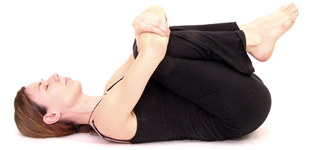
Benefits
- It eliminates fast the intestinal gas which can give headaches, stomach pain and a general indisposition.
- It heals the disorders of the abdomen.
- It has therapeutic benefits for disorders such as gastritis and ulcer.
- It favors the digestion, and thus the body becomes supple and light.
- It has beneficial benefits on the spleen and sexual glands, and it brings relief and stimulates the pancreas and the liver.
- It eliminates constipation and it improved the blood circulation.
- The unpleasant odors of the body disappear as well as the extra weight.
- The pose can be performed by anybody. Even though it appears to be very simple, it has an extraordinary power of transformation if practiced regularly.
- It also improves motivation and determination.
Contraindications
- No counter indications.
Disclaimer
Hatha Yoga & Suzana Panasian makes no warranty or representation whatsoever regarding the services or products provided through or in connection with the website. Use your own discretion when performing these postures. Work at your own level and explore your own limits.
The reader of the information presented by this site assumes all risks from using the information provided herein. This site's operators, authors, owners, and partners disclaim any and all liability from the information provided herein.
